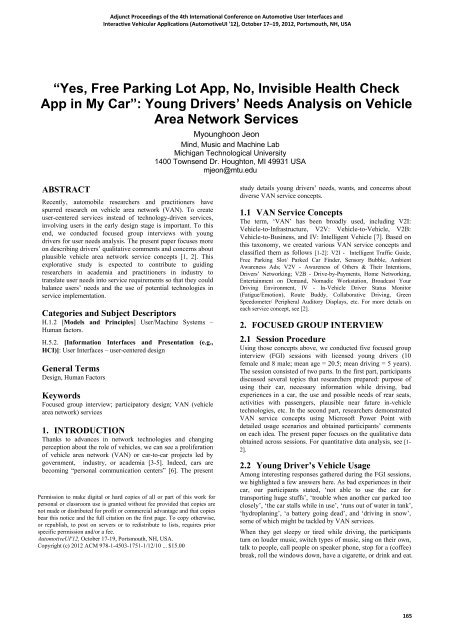12: Adjunct Proceedings - Automotive User Interfaces and ...
12: Adjunct Proceedings - Automotive User Interfaces and ...
12: Adjunct Proceedings - Automotive User Interfaces and ...
You also want an ePaper? Increase the reach of your titles
YUMPU automatically turns print PDFs into web optimized ePapers that Google loves.
“Yes, Free Parking Lot App, No, Invisible Health Check<br />
App in My Car”: Young Drivers’ Needs Analysis on Vehicle<br />
Area Network Services<br />
ABSTRACT<br />
Recently, automobile researchers <strong>and</strong> practitioners have<br />
spurred research on vehicle area network (VAN). To create<br />
user-centered services instead of technology-driven services,<br />
involving users in the early design stage is important. To this<br />
end, we conducted focused group interviews with young<br />
drivers for user needs analysis. The present paper focuses more<br />
on describing drivers’ qualitative comments <strong>and</strong> concerns about<br />
plausible vehicle area network service concepts [1, 2]. This<br />
explorative study is expected to contribute to guiding<br />
researchers in academia <strong>and</strong> practitioners in industry to<br />
translate user needs into service requirements so that they could<br />
balance users’ needs <strong>and</strong> the use of potential technologies in<br />
service implementation.<br />
Categories <strong>and</strong> Subject Descriptors<br />
H.1.2 [Models <strong>and</strong> Principles] <strong>User</strong>/Machine Systems –<br />
Human factors.<br />
H.5.2. [Information <strong>Interfaces</strong> <strong>and</strong> Presentation (e.g.,<br />
HCI)]: <strong>User</strong> <strong>Interfaces</strong> – user-centered design<br />
General Terms<br />
Design, Human Factors<br />
<strong>Adjunct</strong> <strong>Proceedings</strong> of the 4th International Conference on <strong>Automotive</strong> <strong>User</strong> <strong>Interfaces</strong> <strong>and</strong><br />
Interactive Vehicular Applications (<strong>Automotive</strong>UI '<strong>12</strong>), October 17–19, 20<strong>12</strong>, Portsmouth, NH, USA<br />
Keywords<br />
Focused group interview; participatory design; VAN (vehicle<br />
area network) services<br />
1. INTRODUCTION<br />
Thanks to advances in network technologies <strong>and</strong> changing<br />
perception about the role of vehicles, we can see a proliferation<br />
of vehicle area network (VAN) or car-to-car projects led by<br />
government, industry, or academia [3-5]. Indeed, cars are<br />
becoming “personal communication centers” [6]. The present<br />
Permission to make digital or hard copies of all or part of this work for<br />
personal or classroom use is granted without fee provided that copies are<br />
not made or distributed for profit or commercial advantage <strong>and</strong> that copies<br />
bear this notice <strong>and</strong> the full citation on the first page. To copy otherwise,<br />
or republish, to post on servers or to redistribute to lists, requires prior<br />
specific permission <strong>and</strong>/or a fee.<br />
<strong>Automotive</strong>UI'<strong>12</strong>, October 17-19, Portsmouth, NH, USA.<br />
Copyright (c) 20<strong>12</strong> ACM 978-1-4503-1751-1/<strong>12</strong>/10 ... $15.00<br />
Myounghoon Jeon<br />
Mind, Music <strong>and</strong> Machine Lab<br />
Michigan Technological University<br />
1400 Townsend Dr. Houghton, MI 49931 USA<br />
mjeon@mtu.edu<br />
study details young drivers’ needs, wants, <strong>and</strong> concerns about<br />
diverse VAN service concepts.<br />
1.1 VAN Service Concepts<br />
The term, ‘VAN’ has been broadly used, including V2I:<br />
Vehicle-to-Infrastructure, V2V: Vehicle-to-Vehicle, V2B:<br />
Vehicle-to-Business, <strong>and</strong> IV: Intelligent Vehicle [7]. Based on<br />
this taxonomy, we created various VAN service concepts <strong>and</strong><br />
classified them as follows [1-2]: V2I - Intelligent Traffic Guide,<br />
Free Parking Slot/ Parked Car Finder, Sensory Bubble, Ambient<br />
Awareness Ads; V2V - Awareness of Others & Their Intentions,<br />
Drivers’ Networking; V2B - Drive-by-Payments, Home Networking,<br />
Entertainment on Dem<strong>and</strong>, Nomadic Workstation, Broadcast Your<br />
Driving Environment, IV - In-Vehicle Driver Status Monitor<br />
(Fatigue/Emotion), Route Buddy, Collaborative Driving, Green<br />
Speedometer/ Peripheral Auditory Displays, etc. For more details on<br />
each service concept, see [2].<br />
2. FOCUSED GROUP INTERVIEW<br />
2.1 Session Procedure<br />
Using those concepts above, we conducted five focused group<br />
interview (FGI) sessions with licensed young drivers (10<br />
female <strong>and</strong> 8 male; mean age = 20.5; mean driving = 5 years).<br />
The session consisted of two parts. In the first part, participants<br />
discussed several topics that researchers prepared: purpose of<br />
using their car, necessary information while driving, bad<br />
experiences in a car, the use <strong>and</strong> possible needs of rear seats,<br />
activities with passengers, plausible near future in-vehicle<br />
technologies, etc. In the second part, researchers demonstrated<br />
VAN service concepts using Microsoft Power Point with<br />
detailed usage scenarios <strong>and</strong> obtained participants’ comments<br />
on each idea. The present paper focuses on the qualitative data<br />
obtained across sessions. For quantitative data analysis, see [1-<br />
2].<br />
2.2 Young Driver’s Vehicle Usage<br />
Among interesting responses gathered during the FGI sessions,<br />
we highlighted a few answers here. As bad experiences in their<br />
car, our participants stated, ‘not able to use the car for<br />
transporting huge stuffs’, ‘trouble when another car parked too<br />
closely’, ‘the car stalls while in use’, ‘runs out of water in tank’,<br />
‘hydroplaning’, ‘a battery going dead’, <strong>and</strong> ‘driving in snow’,<br />
some of which might be tackled by VAN services.<br />
When they get sleepy or tired while driving, the participants<br />
turn on louder music, switch types of music, sing on their own,<br />
talk to people, call people on speaker phone, stop for a (coffee)<br />
break, roll the windows down, have a cigarette, or drink <strong>and</strong> eat.<br />
165





